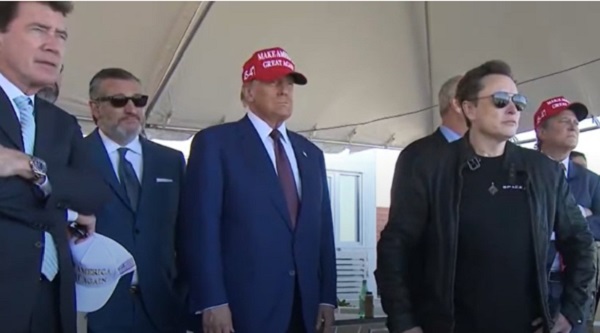Business
Trump’s Initial DOGE Executive Order Doesn’t Quite ‘Dismantle Government Bureaucracy’


From the Daily Caller News Foundation
By Thomas English
President Donald Trump’s Monday executive order establishing the Department of Government Efficiency (DOGE) presents a more modest scope for the initiative, focusing primarily on “modernizing federal technology and software.”
The executive order refashions the Obama-era United States Digital Service (USDS) into the United States DOGE Service. Then-President Barack Obama created USDS in 2014 to enhance the reliability and usability of online federal services after the disastrous rollout of HealthCare.gov, an insurance exchange website created through the Affordable Care Act (ACA). Trump’s USDS will now prioritize “modernizing federal technology and software to maximize efficiency and productivity” under the order, which makes no mention of slashing the federal budget, workforce or regulations — DOGE’s originally advertised purpose.
“I am pleased to announce that the Great Elon Musk, working in conjunction with American Patriot Vivek Ramaswamy, will lead the Department of Government Efficiency (‘DOGE’),” Trump said in his official announcement of the initiative in November. “Together, these two wonderful Americans will pave the way for my Administration to dismantle Government Bureaucracy, slash excess government regulations, cut wasteful expenditures, and restructure Federal Agencies.”
The order’s focus on streamlining federal technology and software stands in contrast to some of DOGE’s previously more expansive aims, including Elon Musk’s claim that “we can [cut the federal budget] by at least $2 trillion” at Trump’s Madison Square Garden rally in November. Musk now leads DOGE alone after Vivek Ramaswamy stepped down from the initiative Monday, apparently eying a 2026 gubernatorial run in Ohio.
The order says it serves to “advance the President’s 18-month DOGE agenda,” but omits many of the budget-cutting and workforce-slashing proposals during Trump’s campaign. Rather, the order positions DOGE as a technology modernization entity rather than an organization with direct authority to enact sweeping fiscal reforms. There is no mention, for instance, of trillions in budget cuts or a significant reduction in the federal workforce, though the president did separately enact a hiring freeze throughout the executive branch Monday.
“I can’t help but think that there’s more coming, that maybe more responsibilities will be added to it,” Susan Dudley, a public policy professor at George Washington University, told the Daily Caller News Foundation. Dudley, who was also the top regulatory official in former President George W. Bush’s administration, said the structure of the new USDS could impact the recent lawsuits against the DOGE effort.
“I think it maybe moots the lawsuit that’s been brought for it not being FACA,” Dudley said. “So if this is how it’s organized — that it’s people in the government who bring in these special government employees on a temporary basis, that might mean that the lawsuit doesn’t really have any ground.”
Three organizations — the American Federation of Government Employees (AFGE), National Security Counselors (NSC) and Citizens for Responsibility and Ethics in Washington (CREW) — separately filed lawsuits against DOGE within minutes of Trump signing the executive order. The suits primarily challenge DOGE’s compliance with the Federal Advisory Committee Act (FACA), alleging the department operates without the required transparency, balanced representation and public accountability.
The order also emphasizes not “be construed to impair or otherwise affect … the authority granted by law to an executive department or agency, or the head thereof; or the functions of the Director of the Office of Management and Budget relating to budgetary, administrative, or legislative proposals.”
“And the only mention of OMB [Office of Management and Budget] is some kind of boilerplate at the end — that it doesn’t affect that. But that’s kind of general stuff you often see in executive orders,” Dudley continued, adding she doesn’t “have an inside track” on whether further DOGE-related executive orders will follow.
“It’s certainly, certainly more modest than I think Musk was anticipating,” Dudley said.
Trump’s order also establishes “DOGE Teams” consisting of at least four employees: a team lead, a human resources specialist, an engineer and an attorney. Each team will be assigned an executive agency with which it will implement the president’s “DOGE agenda.”
It remains unclear whether Monday’s executive order comprehensively defines DOGE, or if additional orders will be forthcoming to broaden its mandate.
Business
The CBC is a government-funded giant no one watches

This article supplied by Troy Media.
 By Kris Sims
By Kris Sims
The CBC is draining taxpayer money while Canadians tune out. It’s time to stop funding a media giant that’s become a political pawn
The CBC is a taxpayer-funded failure, and it’s time to pull the plug. Yet during the election campaign, Prime Minister Mark Carney pledged to pump another $150 million into the broadcaster, even as the CBC was covering his campaign. That’s a blatant conflict of interest, and it underlines why government-funded journalism must end.
The CBC even reported on that announcement, running a headline calling itself “underfunded.” Think about that. Imagine being a CBC employee asking Carney questions at a campaign news conference, while knowing that if he wins, your employer gets a bigger cheque. Meanwhile, Conservative Leader Pierre Poilievre has pledged to defund the CBC. The broadcaster is literally covering a story that determines its future funding—and pretending there’s no conflict.
This kind of entanglement isn’t journalism. It’s political theatre. When reporters’ paycheques depend on who wins the election, public trust is shattered.
And the rot goes even deeper. In the Throne Speech, the Carney government vowed to “protect the institutions that bring these cultures and this identity to the world, like CBC/RadioCanada.” Before the election, a federal report recommended nearly doubling the CBC’s annual funding. Former heritage minister Pascale St-Onge said Canada should match the G7 average of $62 per person per year—a move that would balloon the CBC’s budget to $2.5 billion annually. That would nearly double the CBC’s current public funding, which already exceeds $1.2 billion per year.
To put that in perspective, $2.5 billion could cover the annual grocery bill for more than 150,000 Canadian families. But Ottawa wants to shovel more cash at an organization most Canadians don’t even watch.
St-Onge also proposed expanding the CBC’s mandate to “fight disinformation,” suggesting it should play a formal role in “helping the Canadian population understand fact-based information.” The federal government says this is about countering false or misleading information online—so-called “disinformation.” But the Carney platform took it further, pledging to “fully equip” the CBC to combat disinformation so Canadians “have a news source
they know they can trust.”
That raises troubling questions. Will the CBC become an official state fact-checker? Who decides what qualifies as “disinformation”? This isn’t about journalism anymore—it’s about control.
Meanwhile, accountability is nonexistent. Despite years of public backlash over lavish executive compensation, the CBC hasn’t cleaned up its act. Former CEO Catherine Tait earned nearly half a million dollars annually. Her successor, Marie Philippe Bouchard, will rake in up to $562,700. Bonuses were scrapped after criticism—but base salaries were quietly hiked instead. Canadians struggling with inflation and rising costs are footing the bill for bloated executive pay at a broadcaster few of them even watch.
The CBC’s flagship English-language prime-time news show draws just 1.8 per cent of available viewers. That means more than 98 per cent of TV-viewing Canadians are tuning out. The public isn’t buying what the CBC is selling—but they’re being forced to pay for it anyway.
Government-funded journalism is a conflict of interest by design. The CBC is expensive, unpopular, and unaccountable. It doesn’t need more money. It needs to stand on its own—or not at all.
Kris Sims is the Alberta Director for the Canadian Taxpayers Federation
Troy Media empowers Canadian community news outlets by providing independent, insightful analysis and commentary. Our mission is to support local media in helping Canadians stay informed and engaged by delivering reliable content that strengthens community connections and deepens understanding across the country.
Business
Trump family announces Trump Mobile: Made in America, for America

 MxM News
MxM News
Quick Hit:
On the 10-year anniversary of Donald Trump’s iconic campaign launch, the Trump family announced the debut of Trump Mobile, a new wireless company offering American-built smartphones, 5G coverage, and a values-driven alternative to Big Tech carriers.
Key Details:
-
Donald Trump Jr. and Eric Trump introduced Trump Mobile’s flagship service Monday, calling it a “transformational” alternative aimed at “our nation’s hardest-working people.”
-
The “47 Plan,” priced at $47.45/month, offers unlimited talk, text, and data, free international calls to U.S. military families, telehealth, roadside assistance, and no credit checks.
-
Trump Mobile’s customer support is fully U.S.-based and live 24/7—“not automated,” the company says—while a new American-made “T1 Phone” is slated for release in August.
Diving Deeper:
Marking ten years since President Donald Trump descended the golden escalator to launch his first campaign, the Trump Organization on Monday announced its boldest private sector move yet: Trump Mobile.
Flanked by company executives, Donald Trump Jr. and Eric Trump unveiled the new cellular service, touting it as a patriotic, people-first alternative to legacy providers. “We’re building on the movement to put America first,” Trump Jr. said in a statement. “We will deliver the highest levels of quality and service.”
The cornerstone of Trump Mobile is the 47 Plan. Offered for $47.45/month, the plan includes unlimited data, full 5G coverage across all three major carriers, and a suite of benefits tailored to middle-class families, truckers, veterans, and anyone tired of paying premiums to companies that don’t share their values.
Among the key perks: 24/7 American-based customer service (with “real people,” not bots), comprehensive device protection, roadside assistance through Drive America, and telehealth services including mental health support and prescription delivery. Most notably, the plan includes free international calling to over 100 countries—an effort the Trump family says honors U.S. military families stationed abroad.
“We’re especially proud to offer free long-distance calling to our military members and their families,” said Eric Trump. “Those serving overseas should always be able to stay connected to the people they love back home.”
Unlike traditional providers, Trump Mobile advertises no contracts and no credit checks, appealing to a demographic long underserved by mainstream telecom giants. “Hard-working Americans deserve a wireless service that’s affordable, reflects their values, and delivers reliable quality they can count on,” Eric Trump added.
The company is also preparing to launch the T1 Phone in August—a sleek, gold smartphone “engineered for performance” and “proudly designed and built in the United States.” With that, the Trump Organization is not just entering the mobile market—it’s staking a claim as a direct competitor to Apple and Samsung.
-

 conflict1 day ago
conflict1 day ago“Evacuate”: Netanyahu Warns Tehran as Israel Expands Strikes on Iran’s Military Command
-

 Health1 day ago
Health1 day agoLast day and last chance to win this dream home! Support the 2025 Red Deer Hospital Lottery before midnight!
-

 Alberta2 days ago
Alberta2 days agoAlberta’s grand bargain with Canada includes a new pipeline to Prince Rupert
-

 Energy1 day ago
Energy1 day agoCould the G7 Summit in Alberta be a historic moment for Canadian energy?
-

 Aristotle Foundation1 day ago
Aristotle Foundation1 day agoThe Canadian Medical Association’s inexplicable stance on pediatric gender medicine
-

 Energy21 hours ago
Energy21 hours agoKananaskis G7 meeting the right setting for U.S. and Canada to reassert energy ties
-

 Business2 days ago
Business2 days agoCarney’s European pivot could quietly reshape Canada’s sovereignty
-

 Business21 hours ago
Business21 hours agoCarney’s Honeymoon Phase Enters a ‘Make-or-Break’ Week






